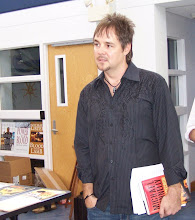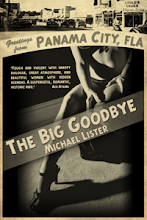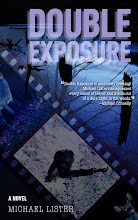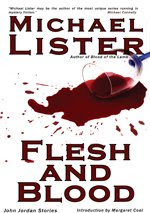
The morning after watching “Solitary Man,” I woke up feeling utterly and completely alone. I’m pretty sure it had nothing to do with the movie—I often experience an intense sense of isolation—but the timing was interesting and thought-provoking.
Being alone isn’t the same as being lonely. Many times I feel the most connected when I am most alone—something Lord Byron captured so beautifully in his phrase, “In solitude, where we are least alone.”
Being with others isn’t the same as not being lonely. Certain people, certain settings and situations, make me feel more lonely, not less. A social gathering involving small talk, cocktail chatter, mundane, surfaces inanities—and what social gathering doesn’t include such things—usually makes me feel far more isolated and alone than when I’m actually by myself.
Whether we’re alone or with others, in one sense we’re always ultimately alone. As Thomas Wolfe said, “Loneliness is and always has been the central and inevitable experience of every human.”
Even as we appear to be sharing the same experiences—including intensely intimate experiences like making love or sharing a meal or talking about God—we’re always having our own unique experience. Oscar Wilde’s observation that there are as many publics as there are people is true of everything. It’s why I say there are some six and half billion gods. No two of us have identical notions of what the word ‘god’ means. So whatever God is and is not, we’re left with our beliefs and perceptions, and though heavily influenced by culture and family, indoctrination and education, they’re still utterly and uniquely only our own.
Beneath all our labels, beyond all our associations and group identities, it’s just us. Ultimately alone. Solitary us. Yet there is an us. We are part of a planet, a species, an interdependent system. We are able to connect, to touch each others’ souls, be inside one another in profound and meaningful ways. At this very moment, you and I are having a personal, intimate (hopefully) meaningful exchange. I am offering you the water of my words and you are drinking them in.
And yet. And yet.
Even as we have truly deep and intensely intimate connections, we remain, in a very real and certain sense, alone. And it’s out of that aloneness, that sometimes painful experience of isolation, we reach out—out of our solitude—to an other.
Solitary means “being, living, or going alone or without companions; saddened by isolation; keeping a prisoner apart from others; being at once single and isolated; occurring singly and not as part of a group or cluster.”
Occurring singly and not being part of a group is a good thing. Emerson said, “Whoso would be a man must be a nonconformist.”
In one sense, the more evolved and self-actualized, the more true to our quidity, the more we refuse to conform, the more alone we will be—less able to fit, less a part of group think and speak. We will not benefit from the safety found in numbers. But this evolution of our beings will also simultaneously, counter intuitively, lead us to a greater awareness of our connectedness with all people, with all things. Connected at very deep levels; completely unconnected at shallower levels.
These are thoughts I’m having as I think of solitude and my experience in proximity to the film. They are not necessarily in the film except in very implicit ways. Ben Kalmen’s solitude originates from the deepest most profound place—his mortality—but his outward isolation isn’t from self-actualization, but its opposite, not out of love, but fear.
“Solitary Man” tells the story of Ben Kalmen, a fifty-something New Yorker and former successful car dealer, who through his own bad choices lost his entire business.
When the film opens, Ben’s on the verge of a comeback, but some of the same motivations that led to his demise are threatening to take him down again. He’s divorced from Nancy, his college sweetheart and the one person who knows him better than anyone. Although he still finds the time to hang out with his daughter Susan and his adoring grandson, she breaks off contact when she discovers he's seeing one of her friends. His girlfriend Jordan is the daughter of a very influential businessman who's on the board of a major auto manufacturer.
If Ben can just keep his hubris in check for a little while longer, he will be back as big as ever. But circumstances place him in very close proximity with the one girl he shouldn’t touch, throwing everything into jeopardy.
“Solitary Man” is solid story elevated by great performances. Michael Douglas is brilliant as Ben, and the other players hovering around the edges of his solitariness hang right there with him.
Ben’s isolation is more an acting out, a childish, defensive way of actually isolating others that leads him to himself be isolated. He’s a solitary man because of bad behavior, because he’s incapable of intimacy.
The sense of isolation—even the experience itself—is part of the human condition. It is not the same as never connecting, as being unable or unwilling to—which seems the case for Ben.
Even in our ultimate aloneness we can connect with others. In fact, we can connect because of it, through it. Sharing our feelings of isolation with another human who is open about his or her own feelings of separation frees us from our solitary confinement prison cell.
Solitude is a good and necessary part of existence. We are our best selves when we have the time and space to be ourselves, to just be—in the beauty and stillness of silence and solitude. Einstein said, “I lived in solitude in the country and noticed how the monotony of a quiet life stimulates the creative mind.”
It comes down to balance. Too much or too little or the wrong kind of solitude negatively impacts our souls. Finding trusted friends who are themselves seeking this same balance and committing to each other to aid in the process is invaluable. As Rilke so wisely put it, “I hold this to be the highest task for a bond between two people: that each protects the solitude of the other.”
Learn from Ben’s mistakes. Identify those in your life who protect your good solitude and make sure you’re protecting theirs. And in those times when you feel all alone, be fully present, and don’t just be alone. Be alone with the promise and possibility of all that can happen.
















